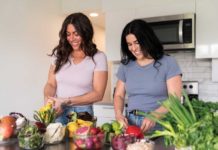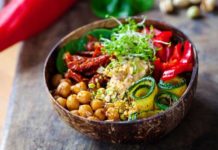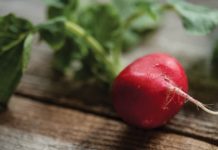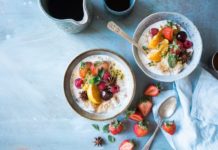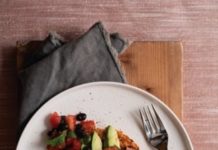
I tried not to panic when my 14-year-old daughter, Emily, decided to adopt a vegetarian diet. As a growing teen, would a vegetarian diet affect her health?
I tried not to panic when my 14-year-old daughter, Emily, suddenly decided to become vegetarian. Turns out, finding adequately nutritious foods to round out meatless meals was more of a challenge than I thought, especially for Emily, who wasn’t exactly fond of vegetables or legumes.
Becoming vegetarian can be a sign of teens asserting their identity,” says Jessica Begg, a Vancouver-based registered dietitian. “Proclaiming they’re vegetarian and the rest of the family isn’t, sets them apart and is an indication they’re exploring who they are separate from the rest of the family.”
Different motivations
Another reason to become vegetarian may be concern about the environment or cruelty to animals, which was true in Emily’s case. “If they’re concerned about cruelty to animals and an environmentally friendly planet, doing vegetarian correctly also means being kind to themselves,” says Mary Bamford, a registered dietitian in Toronto.
Parents need to be especially vigilant that their daughters’ desire to protest cruelty to animals is not just a foil for something more serious. “Kids that age, especially teen girls, sometimes claim they’re vegetarians as a way of hiding an eating disorder. They typically cut out meat first,” says Begg. “Parents need to make sure their daughters are eating enough and that they’re gaining [or] weight appropriately.”
Vegetarian or carbotarian?
One of the first things parents can do is keep an open dialogue with their children, and insist that their new way of eating must become a joint effort. “To go completely vegetarian overnight turns the family upside down and can cause parents a lot of stress,” says Bamford.
I could relate. With my stress meter rising, I chose the easiest, fastest way of satisfying Emily’s dietary wishes. I stopped in at my local health food store and stocked up on vegetarian versions of my daughter’s favourite foods: yam fries, soy nuggets, and tofu wieners. Emily turned her nose up at even the slightest suggestion of black bean dip with pita chips or vegetarian lasagna.
She had become a “carbotarian,” a term used by Bamford to describe kids who still lean heavily toward cheese, pasta, breads, and sweets. “Most of them are not eating enough vegetables or whole grains so their diets become very nutrient-poor. A multivitamin will usually make up for a lack of B12, but it doesn’t make up for the iron or zinc or other minerals you get from beans, peas, lentils, tofu, dark green leafy vegetables, and orange vegetables.”
There is such a thing as an overweight vegetarian. Kids can gain weight yet be undernourished at the same time if their diet consists mainly of high-fat processed foods. Switch deep-fried corn chips for baked kale chips or whole grain pita bread to dip into salsa or hummus, for example.
Health consequences
After a month, Emily began to show the effects of her limited diet. She fell asleep on the couch after school, her complexion was pale, and she dreaded gym class.
“Lack of energy and trouble concentrating in school can be signs that your teen isn’t getting what she needs from her diet. How you approach what you’re seeing is important,” says Begg. “Saying that you notice your child seems more tired that usual is a nonconfrontational way of pointing out what you might think is a dietary issue.”
Bamford says it’s a good idea to make an appointment with your health care practitioner for a baseline checkup. “Tell [them] that your child wants to go vegetarian and you’d like blood work to measure iron and B12 levels. It’s also a good idea to follow up in six months to determine possible gross deficiencies.”
More harm than good?
I worried that Emily was compromising her growth and development with her self-designed carbotarian diet. According to Bamford, it was her brain that I should have been most concerned about.
“You can have a very sound vegetarian diet with all the proteins, minerals, and everything you need. What will be missing will be DHA and EPA, a type of omega-3 fat that usually comes from animals and is essential for brain growth and development in teenagers,” says Bamford. “For a kid who becomes a very strict vegetarian and won’t eat eggs or fish or take a fish oil capsule, they can take an algae source DHA supplement. Fish oil supplements are better as they provide both DHA and EPA.”
Take it slowly
Being vegetarian proved a lot more difficult than Emily expected. After a few months she gave up and returned to eating her favourite roast beef and chicken dinners. “Your child may try and not end up with favourable results,” says Bamford. “That doesn’t mean they won’t one day revisit a vegetarian lifestyle.”
Perhaps Emily was a little overzealous. “When making such a huge dietary change, it’s important to take it slowly. Make an agreement that you are willing to learn one new vegetarian recipe a week as long as your child will try one new vegetable a week,” says Bamford.
“Eating vegetarian during the day but [having] a regular dinner that includes meat in the evening could work. You can point out that they’re still doing a lot for the planet by eating three vegetarian meals a week. The trade-off for eating inexpensive beans means there’s more money available for a grass-fed organic steak.”
Involve the kids
Getting kids involved in meal planning is a good idea. They’re more likely to choose healthy foods if they’re able to voice their likes and dislikes. Being vegetarian does take more work, and they should be aware of that. Balancing out your teen’s daily requirement of nutrients takes planning and preparation.
When your child begins to assert his or her independence, it’s important that the family embraces and encourages it, even if it means making some changes at the dinner table. Why not skip the fast food drive-through and visit a vegetarian restaurant together instead? You might just make some delicious discoveries yourself!
Top 11 tips for teen vegetarians
- Consult Canada’s Food Guide for vegetarian alternatives and serving suggestions.
- Choose meat alternatives that are good protein sources, such as beans, peas, lentils, tofu, and tempeh.
- If they’re vegan, which means cutting out all dairy products in addition to meat, choose calcium-fortified soymilk or calcium set tofu; they’re excellent alternatives to milk.
- Spread tasty almond or cashew butters on apples or bake them in cookies. They have only slightly less protein than peanut butter but contain more minerals such as zinc.
- Switch to fortified whole grain breads and cereals for iron and fibre.
- Decide on DHA and EPA sources for optimal brain development. If your teen won’t eat fish, other good sources are whole grains, fruits and vegetables, and olive oil.
- Give your teen supplements such as iron, B12, or zinc for backup. Consult your health care practitioner for dosage.
- Add a fruit or vegetable that contains adequate amounts of vitamin C to help with iron absorption. Broccoli, kiwi, and oranges are good sources.
- Choose healthy fats. Use a vacuum pump for spraying olive or avocado oil on air-popped popcorn, and sprinkle chili or garlic powder on top for zesty flavour. Forgo butter and salt.
- Sneak practically anything healthy into a smoothie, and your teen won’t even notice. Experiment with different fruits and vegetables to come up with a customized recipe and call it your own.
- Clean out your pantry, and replace all junk foods with healthy alternatives. Make it just as easy to grab a handful of almonds as it is a bag of chips.
Daily food requirements for teens
| Number of servings | |||
| Food group | Females | Males | Serving size |
| Vegetables and fruit | 7 | 8 |
|
| Grain products | 6 | 7 |
|
| Milk and alternatives, such as fortified soy beverages | 3 to 4 | 3 to 4 |
|
| Meat and alternatives | 2 | 3 |
|
—Source: Canada’s Food Guide, hc-sc.gc.ca/fn-an/food-guide-aliment/index-eng.php
Vegetarian resources
| Organization | Expertise | Website address |
| Dietitians of Canada | Meal planning and phone counselling with a registered dietitian | dietitians.ca |
| Vegetarian Teen | Nutrition info for parents and teens, recipes, links to other resources | vegetarianteen.com |
| The Vegetarian Resource Group | Nutrition and ingredient information; section for kids, teens, and families; recipes; vegetarian restaurant guide for Canada and the United States | vrg.org
|
| Vegan Health.org | Nutrition info for children and teens, sports nutrition, meal plans, research | veganhealth.org |
| alive | Articles on vegetarian nutrition and supplementation; recipes | alive.com |



